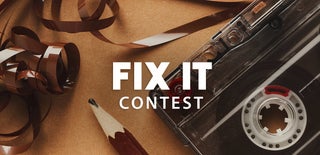Introduction: How to Repair a Burned LED Floodlight
In this instructable I will explain how I fixed my floodlight.
I use my floodlight a lot. After using it for ages two of the SMD LEDs (Surface-Mount-Device Light-Emitting Diode) eventually burned. The perfect time to repair it and write an Instructable about it!
Supplies
For my Instructable I've used the following things:
Tools:
- Pliers
- Utility knife
- Screwdriver
- Soldering iron & solder
Parts:
- Copper wire (any other conductive wire will work too)
Optional:
- Resistor
Step 1: Preparation
Before you do anything make sure you understand what you are doing. Working with electronics requires basic knowledge of circuits.
Never work on a live circuit and make sure to use the right safety measurements!
The first step is to unplug the floodlight (if plugged into a wall outlet). After you've done that you can finally start to inspect the lamp.
Step 2: Inspecting the Lamp
Before you disassemble the lamp you should first inspect it. Question yourself where the problem might be, what could have caused the problem and what could be a possible solution.
In my case the problem was clear. two of the LEDs were burned. If you look closely you should be able to see that the LEDs are connected in series. A possible solution could be to either replace the LEDs or to bypass the burned LEDs. Because I didn't have any SMD LEDs laying around I decided to bypass the burned LEDs.
Step 3: Disassembly
To disassemble the lamp you will need:
- Pliers
- Screwdriver
- Utility knife
Step 1: We start with the screws on the back. Unscrew the 4 screws on the back and remove the frame of the lamp.
Step 2: Grab your utility knife and carefully slice the soft waterproofing glue and remove the glass pane.
Step 3: You'll see 4 more screws holding the aluminium reflector. Unscrew these screws and remove the reflector.
Step 4: Remove the screws of the white piece of plactic holding the circuit and use pliers to carefully remove it.
Step 4: Exposing the Circuit & Repairing It
In this step I will show you how the circuit works and how to repair it.
Tools needed for this step:
- Utility knife
- Soldering iron & solder
- Wire
Optional:
- Resistor
The LEDs are all connected in series. This means current flows in one path. If one component (in our case the LEDs) in a series connection does not function, the whole circuit will break.
Method 1:
As I mentioned before you could unsolder the burned LEDs and replace it with new ones. If you do this make sure to connect the LEDs with the right polarity. In a series circuit you should solder the negative side of the new LEDs to the positive side of the next LED and vice versa. In a parallel circuit you should solder the positive sides together and do the same for the negative sides.
Method 2:
Important note: Voltage splits evenly in a series circuit. If you skip three LEDs the overal voltage will stay the same. This means a higher voltage will be applied on each LED. Make sure your LEDs can handle the voltage or use a resistor in front of the circuit. Otherwise the other LEDs will burn out too!
I am going to bypass three LEDs while I only burned two of them. The reason for that is to keep the circuit as small as possible. The more wires you will use, the bigger the chance of mistakes will be. It is possible to save that one LED between the two burned LEDs but it will make the soldering a lot harder.
Step 1:
Grab your utility knife and scratch off the top layer of the connection between the LED before the first burned LED and the first burned LED. You should be able to see the copper connection.
Step 2:
Scratch off the top layer of the connection after the last burned LED. You should now have two open connections in the circuit. (in the image you will see three open connections. I wasn't paying attention and accidently scratched open the wrong spot).
Step 3:
Put some solder on the open connections and use a piece of wire to connect the two spots together. If your LEDs can't handle the voltage make sure to add a resistor before the first LED or after the last LED. You can calculate the resistance needed with Ohm's law. Because there are plenty of detailed tutorials about Ohm's law I won't be going into it deeply, but it's basically the relationship between voltage, resistance and current. For example, if you know what the voltage and current is, you can calculate the resistance.
Step 5: Testing
Put everything back together and plug the lamp to a wall outlet. If everything is done correctly the lamp will turn on. The LEDs we bypassed should stay off.
On the picture you can see the result in the end. There are some black lines in the picture because the frequency in which light is emitted from the lamp was close to the framerate of my camera. I wasn't able to adjust the framerate so this was the best picture I could get.
Step 6: Troubleshooting
My other LEDs burned out
This problem might occur if your LEDs can't handle the voltage. Make sure to check the datasheet of your LEDs. A simple solution could be to add a resistor in the circuit as I mentioned before.
The lamp won't turn on at all
If you used a resistor the resistance might be too big. The voltage across the LEDs will be too low to turn them on. Always check the resistance of the resistor with a multimeter or by looking up the colors.
If you have any other problems, let me know. :)

Participated in the
Fix It Contest











